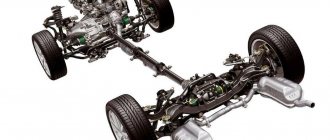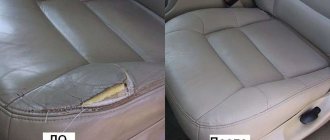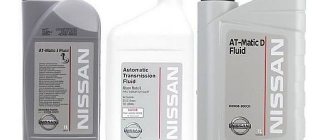FEDERAL ROAD SERVICE OF RUSSIA
VEHICLES, PUBLIC ROADS
Moscow, 1999
FEDERAL ROAD SERVICE OF RUSSIA (FDS Russia)
ORDER
Moscow
On approval of the standards “Maximum weights and dimensions of vehicles operated on public roads”
In order to ensure road safety, reliability and safety of public roads and road structures, taking into account their load-bearing capacity and carrying capacity, I ORDER:
1 . Approve the attached standards “Maximum weights and dimensions of vehicles operated on public roads”, agreed with the Ministry of Transport of Russia and the Ministry of Internal Affairs of Russia. 2. The Department for Ensuring the Safety of Roads of the FDS of Russia (Sorokin S.F.) together with the Legal Department of the FDS of Russia (Enikeev Sh.S.) shall coordinate in the prescribed manner with the interested ministries and departments and submit before June 1, 1999 for approval to the leadership of the FDS of Russia “Rules” passage of heavy and (or) large vehicles on public roads" and "Instructions on the procedure for compensation of damage caused by heavy vehicles when driving on public roads." 3. Control over the implementation of this order is entrusted to the deputy head of the FDS of Russia I.A. Urmanov. Head V.G. Artyukhov
FEDERAL ROAD SERVICE OF RUSSIA
MAXIMUM WEIGHTS AND DIMENSIONS OF VEHICLES OPERATED ON PUBLIC HIGHWAYS
Moscow, 1999
1.1.
The provisions set out in these standards relate to the weight and dimensions of vehicles permitted for use in the Russian Federation on public roads, established on the basis of the requirements for ensuring road safety, reliability and safety of highways and road structures, taking into account their load-bearing capacity and load capacity. The restrictions on the weight and dimensions of vehicles set out below do not apply to the production of vehicles, the requirements for which are established by other standards and regulations. 1.2. Vehicles or parts thereof, forming part of combined vehicles, the dimensions, as well as the total weight and axle load of which do not exceed the values established by sections 3, 4 and 5 of these standards, are allowed to travel on federal and territorial public roads. For other highways designed and built for loads lower than those specified in sections 3, 4 and 5, the owners of highways may set other (smaller) vehicle weight limits; for federal highways - by the Federal Road Service of Russia; for territorial highways roads - by executive authorities of the constituent entities of the Russian Federation, for municipal roads - by local government bodies. Decisions to reduce the dimensions and weights of vehicles listed below are made based on the results of a road survey and may be permanent or temporary. In this case, the body that made such a decision is obliged, in accordance with the established procedure, to install the appropriate road signs on the highway or its section on which additional restrictions on the weight and size of vehicles have been introduced and to inform road users about this. 1.3. A vehicle and its part forming a combined vehicle, the mass and/or axle load of which and/or the size of which exceed the maximum values established by these standards, may be driven on roads only with special permits issued in the prescribed manner by the competent authorities. The movement of such vehicles on roads is carried out in accordance with the “Instructions for the transportation of large-sized and heavy cargo by road on the roads of the Russian Federation”, approved by the Ministry of Transport of Russia on May 27, 1996. 1.4. In addition to the maximum values of the total mass and axle loads established by these requirements, the mass of the transported cargo and the load distribution along the axles must not exceed the values established by the manufacturer for a specific vehicle. 1.5. For the purposes of these standards, the following concepts and definitions are used: Vehicle - a device intended for transporting goods and passengers along roads; Truck - a vehicle designed and built exclusively or primarily for the transport of goods; Tractor means a vehicle designed and constructed solely or primarily for towing a trailer or semi-trailer; Trailer is a vehicle designed for transporting goods by towing with a tractor or truck; Semi-trailer - specially equipped for the transportation of goods, designed to be connected to a tractor in such a way that part of this vehicle is located directly on the tractor and transfers a significant portion of its weight to it; Road train is a combined vehicle consisting of a truck and a trailer; Articulated vehicle - a combination vehicle consisting of a tractor unit articulated with a semi-trailer; Bus - a vehicle designed to transport passengers and their luggage, having more than nine seats, including a seat for the driver; Articulated bus
- a bus consisting of two or more rigid sections connected to each other and having a passenger compartment in each section, allowing passengers to move freely from one compartment to another;
Combination vehicle
- a combination of a commercial vehicle consisting of a truck coupled to a semi-trailer;
Maximum length, width and height of a vehicle -
the length, width and height of a vehicle with or without cargo, not exceeding the values specified in Section 3 of these standards;
Maximum linear parameters of a vehicle -
linear parameters not exceeding the values specified in section 3 of these standards;
Maximum weight of a vehicle
- the weight of a vehicle with or without cargo, which does not exceed the values specified in Section 4 of these standards;
— mass transmitted through the vehicle axle to the surface of the road, not exceeding the standard value; Indivisible cargo
- cargo that, when transported by road, cannot be divided into two or more parts without excessive costs or risk of damage and which, when loaded onto a vehicle, will exceed its maximum dimensions and weight;
Air suspension
is a suspension system in which air is the shock-absorbing element;
Trolley
- two or more axles having a common suspension to the vehicle;
Single axle
- an axle of a vehicle located at a distance of more than 1.8 m from the nearest axle of that vehicle;
Close axles
- axles (two or more) of a vehicle located at a distance between them of less than 1.8 m. 2.1.
The length of the vehicle is measured in accordance with ISO 612-1978 clause 6.1. However, when measuring length in accordance with the provisions of this standard, the following devices mounted on the vehicle are not taken into account: window cleaning device and mud flaps; front and side marking plates; devices for sealing and protective devices for them; devices for securing tarpaulins and protective devices for them; equipment for electric lighting; rear view mirrors; devices for viewing the space behind the car; air tubes; length of valves and connectors for connection to trailers or swap bodies; steps for access to the body; tire lift; lifting platforms, access steps and similar equipment not exceeding 200 mm in operating position and designed in such a way that they do not increase the vehicle's loading weight limit; coupling devices for towing vehicles or trailers. 2.2. Vehicle height is measured in accordance with ISO 612-1978 clause 6.3. Moreover, when measuring height, taking into account the provisions of this standard, the following devices mounted on the vehicle should not be taken into account: antennas; pantograph in raised position. For vehicles equipped with a device for lifting an axle, the effect of this device is taken into account. 2.3. The width of the vehicle is measured in accordance with ISO 612-1978 clause 6.2. When measuring the width of a vehicle, taking into account the provisions of this standard, the following devices mounted on the vehicle should not be taken into account: devices for seals and seals and protective devices for them; devices for securing tarpaulins and protective devices for them; devices for identifying damage to tires ;
protruding flexible parts of mudguards; Lightning equipment; steps in the operative position, suspended platforms and similar equipment which, in the operative position, do not exceed 10 mm on each side of the vehicle and face forward or rearward, the corners of which are rounded with a radius of not less than 5 mm, and the edges of which are rounded with a radius of not less than 2 .5 mm; rearview mirrors; tire pressure indicators; retractable or retractable steps; the curved portion of a tire's surface that extends beyond its point of contact with the ground. 2.4. The axial mass of a vehicle is measured with a dynamic vertical load transmitted through a single axle to the surface of the road from a loaded vehicle. The measurement is carried out with special vehicle scales that have been certified in the prescribed manner. The axial mass of a trolley located on one suspension, taking into account the design of the vehicle, is determined as the sum of the measurements of the mass of each of the axles included in the trolley. 2.5. The gross mass of a vehicle or part thereof forming part of a combination vehicle is determined as the sum of the measured masses of all axles of the vehicle or part thereof. The maximum dimensions of vehicles, taking into account the dimensions of swap bodies and cargo containers, including containers, must not exceed the values given below. 3.1. Maximum length: truck - 12.00 m trailer - 12.00 m articulated vehicle - 16.5 m articulated bus - 18.00 m road train - 20.00 m 3.2. Maximum width: all vehicles - 2.50 m 3.3. Maximum height - 4.00 m 3.4. The maximum distance between the axle of the coupling device and the rear of the semi-trailer must not exceed 12.00 m. 3.5. The maximum distance measured parallel to the longitudinal axis of the road train from the outer front point of the body or the cargo stowage area behind the cab to the rear outer point of the trailer, minus the distance between the rear of the tractor and the front of the trailer, shall not exceed 15.65 m. 3.6. The maximum distance, measured parallel to the longitudinal axis of the road train, from the outer front point of the body or platform for loading cargo behind the cab to the rear outer point of the semi-trailer must not exceed 16.40 m. 3.7. The load installed in the body of the vehicle must not protrude beyond the rear outer point of the vehicle or trailer by more than 2.00 m. 3.8. The distance between the rear axle of the truck and the front axle of the trailer must be at least 3.00 m. 3.9. The horizontally measured distance between the semi-trailer's hinge axis and any point on the front of the semi-trailer must not exceed 2.04 m. 3.10. When moving, any vehicle must be able to turn within a space limited by an outer radius of 12.50 m and an inner radius of 5.30 m. 3.11. The maximum distance between the coupling locking axis and the rear of the combination vehicle must not exceed 12.00 m. * Regulatory gross vehicle weights must not be exceeded by more than 20%.
Table 4.1
| Vehicle type | Standard total weight of the vehicle, t | |
| Trucks a) two-axle vehicle | ||
| b) three-axle car | ||
| d) a four-axle vehicle with two driven axles, each of which consists of two pairs of wheels and has air or equivalent suspension | ||
| Vehicles forming part of a combination vehicle a) two-axle trailer | ||
| b) three-axle trailer | ||
| Combined vehicles Articulated vehicles | ||
| a) a two-axle tractor with a two-axle semi-trailer with a total base of 11.2 m or more | ||
| b) a two-axle tractor with a three-axle semi-trailer with a total base of 12.1 m or more | ||
| c) a three-axle tractor with a two-axle semi-trailer with a total base of 11.7 m or more | ||
| d) three-axle tractor with three-axle semi-trailer with a total base of 12.1 or more | ||
| e) a vehicle consisting of an 18-ton truck and a 20-ton semi-trailer if the vehicle has a drive axle consisting of twin wheels and is equipped with an air or equivalent suspension with a total base of 13.3 m or more | ||
| Road trains a) two-axle truck with two-axle trailer with a total base of 12.1 m or more | ||
| b) a two-axle truck with a three-axle trailer with a total base of 14.6 m or more | ||
| c) a two-axle truck with a four-axle trailer with a total base of 16.5 m or more | ||
| d) a three-axle truck with a two-axle trailer with a total base of 14.6 m or more | ||
| e) a three-axle truck with a three-axle trailer with a total base of 15.9 m or more | ||
| e) a three-axle truck with a four-axle trailer with a total base of 18 m or more | ||
| Buses a) two-axle bus | ||
| b) three-axle bus | ||
| c) three-axle articulated bus | ||
| d) four-axle articulated bus | ||
Table 5.1.
Standard axle loads of vehicles *
* Axle loads of vehicles should not exceed standard axle loads by more than 40%.
| Types of vehicle axles | Estimated axial load for which the road pavement is designed, tf | |||
| gable | single-pitched | |||
| Single axes | ||||
| Twin axles of trailers, semi-trailers, drive axles of trucks and buses at distances between axles: | ||||
| d) equal to or more than 1.8 m | ||||
| Triple axles of trailers and semi-trailers with distances between axles: | ||||
| a) more than 0.5 m, but less than 1.0 m | ||||
| b) equal to or more than 1.0 m, but less than 1.3 m | ||||
| c) equal to or more than 1.3 m, but less than 1.8 m | ||||
| d) equal to or more than 1.8 m | ||||
| - the same when mounted on an air suspension or an equivalent suspension | ||||
5.8. The weight transmitted to the drive axles or drive axles of the vehicle or combination vehicle must not be less than 25% of the total weight of the vehicle or combination vehicle.
| 1. General Provisions. 2 2. Measuring the mass and dimensions of vehicles. 3 3. Maximum dimensions and other parameters of vehicles. 4 4. Standard total weight of vehicles. 5 5. Standard axle loads of vehicles. 6 |
In the automotive industry and everything connected with this area, two basic concepts are used: curb weight of the car and gross weight of the car. These two characteristics are those that are necessarily discussed during theoretical classes held at a driving school. However, many, even very experienced, drivers do not know or have simply forgotten what lies behind this terminology.
What is the difference between curb and gross vehicle weight?
If you understand the differences between these two concepts, then the point is what exactly is included and summed up in the overall mass indicator. Unlike the indicator of the curb weight of a car, the indicator of its total weight also takes into account the weight of the driver, the weight of the passengers of the car, and the weight of the cargo that is located (transported) in it.
It is absolutely natural that people are all different - each person has a different weight. The same applies to car luggage - some drivers can “pack the car” so that it cannot move, while some drivers treat it more carefully and transport cargo within reason. In this regard, the concept most often used among motorists is “permissible gross vehicle weight”. Each car has its own highest permissible mark, it all depends on the manufacturing company, the materials that were used in the production process of the car, as well as the structure of the car body and other load-bearing parts of the car. It is important not to load your own car so much that this figure is exceeded. If you do not adhere to this, then gradually during the operation of the car its body, axle systems, as well as many other parts that are attached to the car’s suspension will be deformed. It is also necessary to take into account that with the vehicle’s full curb weight, it will absorb significantly more fuel.
An overloaded vehicle, both passenger and truck, is a great danger for the driver and other road users. In addition, it creates an increased load on the road surface, which suffers in any case. How to calculate overload, and what are the current fines for driving with violations? Every driver must understand his responsibility and know what he faces.
The curb weight of the car is the starting weight equivalent
In the field of cars and everything connected with them, there are two concepts: gross weight and curb weight of the car. These are two characteristics that are always talked about during theoretical classes at a driving school, but many, even the most avid drivers, manage to forget this terminology. In order to make it clear what all this means and how it affects the car itself, let’s try to consider this issue in detail.
Brief interpretation of the term
So, the curb weight of a car is the total weight of the car. It includes all running parts, all electrical equipment, interior contents (including audio-video equipment), as well as consumables such as engine oil, coolant and fuel (full tank). The indicator of this weight unit does not include the weight of the driver and passengers, as well as cargo and other parts that do not affect the operation of the vehicle’s chassis system. Based on the term itself, one can understand that this is the very “equipment”, that is, equipment that ensures complete readiness for the process of movement, braking, sliding, and so on.
Gross and curb weight of the vehicle: differences
Unlike the curb weight, the full weight also includes the weight of the driver, passengers and transported cargo. It is clear that all people are different, and each is characterized by its own mark on the scale. The same applies to luggage - you can pack a car so that it won’t budge. That is why the concept of “permissible gross vehicle weight” is most often used among motorists. Each car has its own highest permissible mark, it all depends on the manufacturer, the materials used in the construction, as well as on the structure of the body and other load-bearing parts
It is important not to load your car so much that this figure is exceeded. Otherwise, the body will gradually deform, as well as axle systems and other parts that are attached to the suspension
Exceptions to machine rules
As mentioned above, the curb weight of a car is the weight that is characteristic of it when fully “equipped”, with all consumables and accessories present. However, in some European countries, this weight unit also includes the weight of the driver, but only if it does not exceed 75 kilograms. Europeans came to this conclusion because it is the driver who causes the car to move, and without him the driving process will become impossible. In Russia, the curb weight of a car is, in addition to all the mentioned parts, also a spare wheel, tools that can be useful on the road in case of an accident or breakdown, and sometimes a canister with spare fuel.
Vehicle weight and maximum speed limit
It is also known from physics lessons that heavier objects will always move at lower speeds, since they have to overcome greater resistance. What does the curb weight of a car and its technical characteristics mean, how do they interact with each other? In order not to delve into the study of the features of each model of each brand of modern cars, we will consider this issue using two types of cars: a two-seater coupe and an SUV. The weight of the first car, of course, is light. Yes, a significant part is occupied by the engine, injectors and everything that ensures fast acceleration of a sports car. However, its body is small, there are only two seats in the cabin, and there is no luggage compartment. The weight of a jeep is two or even three times greater, it has five or six seats, and a multi-liter trunk. The fuel tank, the volume of which is always extremely large, also takes up a lot of space. Logically, the Audi TT RS will move faster and more maneuverable than the Infiniti FX 35.
Permissible vehicle weight
In the summer of 2020, changes to the relevant acts on the transportation of goods on Russian roads came into force. Based on this document, new standards for permissible vehicle weight have been introduced.
For example, the maximum weight of a car that has the right to drive onto the road without additional permission is 44 tons. This is the ultimate maximum.
For passenger cars, of course, such standards do not exist. But does this mean that you can overload your car and drive with impunity? There is still a limit. It consists in the fact that it is prohibited to transport a large number of passengers. This is punishable by an appropriate fine.
Maximum dimensions of cargo vehicles
The maximum permitted parameters for heavy-duty transport are established in the agreement of the CIS countries. According to him:
- The length of a car, trailer and bus should not exceed 12 m; for an articulated bus this parameter is 18 m, and for a road train - 20 m. Lifting platforms, steps, windshield wipers, and mirrors are not taken into account when calculating the length.
- The width of any vehicle is less than 2.55 m. This does not include lighting fixtures, stairs and steps, platforms, mirrors, tire pressure indicators.
- The permitted height is 4 m, including the body or container.
Permissible axial load
For freight vehicles, the axle load rule applies. This is the most important point in the calculations. In order to understand exactly how the load is calculated, you need to understand the simplest concepts.
So, all cars are divided into two classes:
- “A” - used on highways of three categories: first, second and third, respectively.
- “B” - travel on any road.
The following are valid values.
First of all, for cars:
- with two axles - 18 tons;
- with three axles - 25 tons;
- with four axles - 32 tons;
- with five axles - 35 tons.
As for road trains, other standards have been established for them:
- with three axles - 28 tons;
- with four axles - 36 tons;
- with five axles - 40 tons;
- with six axles or more - 44 tons.
How to calculate?
The load is calculated using a complex formula. You also need to take into account the maximum weight for roads of a certain category. The load of a truck is distributed as follows: it is less on the front axle, and it is much higher on the rear (or rear) axle.
When a car drives onto the scales at the post, the control officer uses a special reference book, which contains a huge number of types of vehicles and a detailed description of the load on their axles. Let's look at a few examples and determine how it folds onto each axis.
The GAZelle cargo truck has two axles: front and rear. The total weight of the car is calculated according to the formula:
M TS = N PO + N ZO, where:
It would seem that everything is simple, but for other vehicles it is not always possible to apply this formula. Three-axle vehicles with two axles combined must be calculated differently. For example, let's take the Kamaz-53215 car. The calculation is already carried out according to the formula:
M TS =N PO +N t, where:
- M TC is the mass of the vehicle;
Table
Let's look at the table of permissible loads. Please note that the standards are given for each axis.
The calculation must be made as accurately as possible, since the error can be no more than 5%. The closer the axles are to each other, the greater the pressure on the road surface. This is what explains the dependence on distance.
Vehicle electrical mass
Water will not flow through a hydraulic circuit unless the lines form a closed path from the tank, through the entire system, and back into the tank. This principle also applies to the electrical system - electric current will not flow unless there is a closed electrical circuit.
When a circuit containing a battery is formed, small electrical charges called electrons move through the circuit. These charges pass through the battery, through the wires and back into the battery, the movement of the charges being stimulated by the battery. When there is an electric current, all the electrons in different parts of the circuit move at the same time, which explains why there must be a closed circuit for the current to flow. The flow of current is like the flow of water in a tube that is bent into a loop and filled with water. There will be no flow of water in any part of the tube unless a corresponding movement of water occurs in other parts of the tube. A simple electrical circuit is formed by connecting a lamp and a switch to a battery. In Fig. Figure 36.2 shows two ways of representing a circuit: as a drawing and as a diagram. The flow of electric current is controlled by a switch, which breaks the circuit and stops the flow of current, acting like a faucet in a plumbing system. A lamp is connected to the switch, and the current flows through a thin coil of wire, heats it up, as a result the spiral begins to glow.
The terms "closed circuit" and "open circuit" mean that the electrical circuit is complete or incomplete.
Using the metal car body and frame as part of the electrical circuit reduces the length of the wires used and simplifies the connection. The frame of the car is called the "ground" and is connected to one of the battery terminals. Typically, ground is the negative terminal of the battery; in this case the polarity is called "negative ground". When a lamp is connected to a battery with two wires, one of the wires is called the "supply" wire and the other wire is the "return" wire. If we assume that the car body is the return wire, then there will be a system with return through ground (Fig. 36.3). (These terms - “supply wire”, “return wire” are purely conventional, since for definiteness it was agreed that the current flows from the positive pole to the negative, although it could be the other way around. All these are conventions that are in no way related to the physical nature of the current , since the current can equally be considered to be the movement of electrons (negative particles) or the movement of places where there are not enough electrons (called "holes" - positive particles).An alternative circuit of two wires is called an isolated return circuit; it is rarely used in cars, except in special purpose vehicles, for example, in fuel trucks.
It is important that the battery terminals are connected with the correct polarity. If they are mistakenly connected in a different way, serious damage may result, especially to devices containing electronic components.
Legislative restrictions in other countries
When sending a loaded vehicle outside of Russia or to pick up goods, it is important to study the legislation in order to avoid fines, which can significantly affect the budget.
Below is a table that can be used to determine the gross permissible weight of vehicles in some countries.
| Countries/vehicle | biaxial | triaxial | four-axle | 2 axle trailer | 3 axle trailer | road train with 4 axles | road train with 5 and 6 axles | semi-trailer road train 3 axles | semi-trailer road train 4 axles |
| Poland | 19 | 26 | 30 | 18 | 24 | 37 | 40 | 29 | 38 |
| Germany | 17 | 24 | 32 | 18 | 24 | 35 | 40 | 27 | 35 |
| France | 19 | 26 | 26 | 19 | 24 | 38 | 40 | — | 38 |
| Belgium | 19 | 28 | 32 | 20 | 30 | 38 | 44 | 29 | 39 |
| Spain | 20 | 26 | 26 | 20 | 26 | 38 | 38 | — | 38 |
| Belarus | 20 | 25 | 26 | 20 | 26 | 36 | 44 | — | 38 |
| Kazakhstan | 18 | 25 | 32 | 18 | 24 | 32 | 44 | 28 | 38 |
Transport companies carefully study the information and laws of other countries and insure those who contact them.
Statistical and dynamic weighing
At special points located on the highway, control weighing takes place in order to determine whether the car is overloaded and what the axle load is.
Weigh it in two ways:
- in statics;
- in dynamics.
Both of these methods are used today, let’s find out what their differences are. So, static weighing occurs like this: a car drives onto the scales and stops. This method determines the exact weight of the vehicle at the moment.
Dynamic weighing occurs when the vehicle is moving slowly. This method is necessary to determine the load on each axle. The car moves on the scale at a speed not exceeding 5 km/h.
The only disadvantage of this method is the error, which you definitely need to be aware of. The maximum can be 3%.
All scales used today at weighing points are predominantly electronic. Entry to them is made using a ramp. It is not always the case that two types of scales are installed at the same post.
Car load capacity - refresh your memory
The importance of the load capacity parameter
To make everything clear to absolutely everyone, I will provide basic information related to our question. In general, these data are mostly included in the mandatory theoretical training program before obtaining a license (driver's license - DL). But most drivers remember this section vaguely (if it was studied in fact, and not by tick) and because of this they are often confused in the terminology associated with carrying capacity.
Doesn't count as a full-fledged seat
On the other hand, this carrying capacity itself, in the case of passenger vehicles, is not of primary interest to car owners. The most questions when buying a car are its price, “gluttony”, speed qualities, etc. indicators.
But it is the weight characteristics that determine most of the popular basic qualities of a car. This has long been used by automakers as one of the fundamental principles in the evolution of branded models, and by now they have become very thin.
By the way, this was not always the case: at the beginning of the second half of the twentieth century. heavy passenger vehicles were in favor. As an example, I can cite the famous Cadillac Eldorado, which reached a weight of almost three tons :shock:, in its V8.2 modification in 1970.
Therefore, whether you buy a used car second-hand, or take a new one at a car dealership, be sure to pay attention to its load-carrying capacity parameters, along with the most important information.
Necessary terminology in the carrying capacity of passenger cars
I would like to note right away that the sections of necessary knowledge on the carrying capacity of passenger cars and trucks differ significantly.
And since the profile of this autoblog concerns more owners of passenger cars, I will not dwell on such subtleties as calculations of carrying capacity for OKOF (All-Russian Classifier of Fixed Assets), or for wheel formulas SSU (Fifth-fifth coupling devices), so as not to immerse you in specific the jungle of accounting and wheel mechanics.
So, for vehicles there are four basic terms that characterize its carrying capacity:
- Dry weight is the true weight of the vehicle as a structural mechanism, without taking into account its ability to function. That is, this is the weight of the device itself without additional fillers that provide or insure its functionality (gasoline, oil, various liquids, standard tools and spare parts).
- Curb weight is the functional weight of the vehicle with all the fillers necessary for its operation (gasoline, oil, various liquids, standard tools and spare parts), including the driver.
- Gross weight (GVW) is the sum of the curb weight of the vehicle, its passengers and its cargo.
- Carrying capacity is the payload that a vehicle can carry without problems (passengers, luggage).
Next, you definitely need to know what corresponds to what according to the technical passport (PTS).
In the Russian Federation, it is customary to write this data in the PTS somewhat differently. Only the curb and gross weight are indicated there:
- Curb weight is reported as "Unladen Weight";
- Gross weight as "Permitted maximum weight".
Remember this.
I hope everything is clear here? I think yes.
Some nuances related to the carrying capacity of vehicles
The information that I wrote about in the previous subsection will not be complete without highlighting some of the features associated with it. This will either be directly useful, or it will just be interesting.
Here's what I wanted to clarify for you:
- Legislative rules regarding the carrying capacity of a vehicle are directly related to its class. And to a greater extent this concerns the data specified in the PTS rather than the actual indicators (and they can differ, sometimes quite significantly).
- The classification of cars itself is quite arbitrary - there is no longer a particularly clear boundary between neighboring classes in modern cars. Moreover, it also has brand dynamics (class variability from model to model), as well as regional differences, depending on the legislation adopted in each country.
- There are regional differences (by country) in the very interpretation of the terms of carrying capacity I have given. For example, previously in Russia (as well as in the USSR), the driver’s weight was not included in the curb weight. Now, in accordance with data unification, this indicator is included (based on EU Directive 95/48 and in accordance with GOST R 52389-2005).
But confusion on the last point, and on other indicators, still arises. And not only among ordinary drivers, but also among customs officers, MREO and traffic police, which you should especially note to yourself, because some employees, due to their poor professional suitability, can “slap” you in the PTS in terms of carrying capacity, not to mention necessary, or issue an unreasonable fine.
What else?
I’ll probably also clarify about mass and weight, since I myself used both terms with an equivalent meaning and encountered fierce debates on this issue on auto forums. The debate on this point is mainly among those who simply want to “show off” with their A’s in physics, thereby misleading the reading public who are looking for reliable information.
Therefore, keep in mind that in cases of calculations and other operations with the carrying capacity of cars (and especially cars) for a simple driver (outside laboratory studies), the concepts of mass (a measure of the inertia of a body) and weight (the force of gravitational pressure) are equivalent, despite the fact that for physicists, the latter is about 10 times larger than the former, if we count for our home planet.
Responsibility for overload
Undoubtedly, all citizens who own cars know that there is liability for overloading. Most often, truck drivers encounter this. Owners of passenger vehicles for the most part do not think about overload at all.
The maximum permissible weight of a car, if you do not take into account the load on the axles, is set even before the car leaves the assembly line. Each vehicle document contains a line regarding this point.
The manufacturer himself knows what load the car can withstand. This is influenced by many factors: from the parts used in production to the distance between the axles.
What does overload lead to?
Overload liability is a very serious matter. Such actions sometimes lead to serious consequences, including:
- Creation of an emergency situation. An overloaded car moves unstably along the road. In addition, the load creates pressure on the axle, which at one point may not withstand.
- Destruction of the road surface. It's hard to argue with this, but overloaded cars really do ruin the roads. Potholes are a huge problem in the country; fines are not always able to cover the damage caused.
- Car parts and components quickly become unusable, and the vehicle itself becomes obsolete and breaks down.
- If the car is overloaded, the braking distance will be longer, which will create an additional risk of an emergency.
These are not all the factors on the basis of which drivers can be severely fined.
Freight car
Truck drivers also need to remember how to properly transport certain types of cargo:
- large-sized;
- dangerous and others.
Fines for violation are provided for in Article 12.21 of the Code of Administrative Offences. They are divided into three types:
- for an individual - 1500-2000 rubles;
- for an official - up to 15,000 rubles;
- for a legal entity - up to 400,000 rubles.
In some cases, when transporting goods, a transport permit may be required. If it is not there, then you will also face a fine.
In some situations, when documents have been drawn up for the cargo and the weight does not match what is presented in the papers, the inspector may additionally impose a fine of 5,000 rubles. For companies it will increase at least 50 times.
The traffic police inspector does not have the right to issue a fine if the control weighing has not occurred. Overload can be determined by eye, but there is no way to prove it.
A car
The Code of Administrative Offenses does not say a word about overloading passenger vehicles. Nobody weighs them on the road. In this case, the inspector may find another reason to issue a fine.
Those who load a passenger car to capacity know how this affects handling, skidding and wear of parts. Most often, drivers of passenger cars are fined for improperly transporting passengers. They can be placed exactly as much as was approved in the documents.
The fines are as follows:
- warning;
- 500 rubles for violating transportation rules;
- 1000 rubles for not wearing a seat belt.
So, overloading a car is a serious violation for which liability is provided. Before you go on the road, study the rules well. If transport companies take all responsibility upon themselves, then a private driver will have to answer for everything on his own.
Question from a reader:
«Good day. Help me figure out the weight of the car! There are many different indicators, my head is spinning, and two are listed in the PTS! For example, what is the permissible weight of a car? What does it mean - no load? And lastly, what is the curb weight of the car? Thank you in advance. Luda
»
The question is really interesting. I will try to explain in simple words, read our article...
To begin with, it’s worth noting that this is a very important characteristic. Using this value, you can calculate fuel consumption, as well as the dynamic characteristics of the car. For example, a car with the same technical component (engine power and identical transmissions) may differ in dynamics due to the weight of the car. Even a difference of 20 - 50 kg can greatly affect the dynamics of the car, the difference can be 1-2 seconds, and this is significant. That is why everything unnecessary is removed from racing cars in order to lighten the body as much as possible and, accordingly, increase the dynamics of the car. Also, the lighter your car, the less it consumes. If the car body is light, the engine does not need to push the heavy body at high speeds; medium speeds are enough and the speed is gained, so the consumption is lower.
As you can see, mass affects a lot of things. Therefore, manufacturers are trying to make the bodies of modern cars as light as possible, using stronger and lighter materials such as aluminum alloys, carbon fiber, etc.
But as you correctly noted in the PTS, and in the car’s operating book, there are many different masses. Let's go in order.
The concept of curb weight
This is the most common concept that automakers, official dealers focus on, and which drivers themselves look at.
The curb weight of any vehicle is the weight or mass of the vehicle, which includes the weight of all standard equipment, operating materials, but does not take into account the weight of cargo, passengers and driver.
Standard equipment usually includes spare parts and tools. As for operating materials, we consider fuel, engine and transmission oil, coolants and other components.
You can describe somewhat differently what the curb weight is in any factory car. This is the total weight of the components of the vehicle, empty in terms of cargo, driver and passengers, but with the fuel tank filled, with all standard tools, equipment and operating fluids. In fact, this is the car in the form that is delivered to car dealerships. It contains everything you need, but there is nothing superfluous, which the car owner himself will gradually accumulate.
Determining the meaning of this characteristic is not difficult. This is due to the fact that the curb weight, like the total vehicle weight, is often . But they mean different parameters. Therefore, first you should look at the technical data sheet. Also, such information is available even before purchasing a car, since manufacturers and sellers must include these parameters in the list of technical characteristics.
It is important to add that the EU has adopted a slightly different standard, according to which the driver’s weight is included in the total curb weight. This takes into account the standard weight of 75 kilograms.
The decision is well founded and has a logical explanation. The point is that the movement of a vehicle will be impossible if there is no person in it, that is, a driver. It is considered a significant component of the car, which is why automakers consider it incorrect to classify drivers as payloads.
Curb weight has another name. This is the unloaded mass. As for the total weight of the vehicle, things are somewhat different.
It is the concept of gross weight that additionally includes the weight of equipment, consumables, driver, cargo and passengers. From here it is not difficult to determine the difference between these two concepts. It consists in the weight characteristics of the passengers in the car, the driver himself and the cargo located in the cabin or luggage compartment.
Another important characteristic is the dry weight of the vehicle. This includes the net weight of the machine itself and its structure. In this case, the weight of standard equipment, fuel, and consumable fluids should be subtracted from the curb weight. Then we get that same dry mass.
Calculation features
Each country has the right to use its own formula to determine the curb weight of a particular vehicle. This is not surprising, since this criterion is key for allowing vehicles to enter areas where there are weight restrictions. This primarily applies to bridges, as well as dams and other similar structures.
As already noted, in Europe they additionally add the average weight of a motorist, that is, an indicator of the average weight of a person. This way you can better generate data on the weight of the car.
If we talk about the rules for the Russian Federation, then when calculating curb weight the following points are taken into account:
- 75 kilograms. As in the case of the European Union, in Russia there is a rule of adding the average weight of a person to the curb weight. It is based on the simple concept that the driver acts as an essential component for the movement of the vehicle;
- if these are trucks or buses intended for, with a structurally provided space for a crew member, 75 kilograms are also added;
- tools. The curb weight must include a list of tools necessary for the motorist;
- 90%. This is the volume of a filled fuel tank that is included in the curb weight. If we take a standard tank volume of 60 liters and roughly calculate the mass of fuel, it turns out that about 55 kilograms are taken into account as an addition to the curb weight;
- spare tire A spare wheel is a mandatory component;
- jack, fire extinguisher, etc.
By summing all these parameters with the dry weight, the final value is obtained, which is indicated in the technical documentation of the car.
It is worth noting the fact that there are special formulas that allow you to individually calculate curb weight. This is especially true for freight vehicles that pass through special points for the weighing procedure. If you subtract the curb weight from the scale indicators, you can find out the exact weight of the cargo, maximum weight and other characteristics.
Therefore, in certain situations, regulatory services use calculation formulas to determine this parameter.
Why is it important to know her
There are a number of life situations for a motorist when he needs or simply needs to know exactly the parameters of the curb weight of his vehicle.
Each vehicle has a certain weight limit for transported and towed cargo. If you get stuck and ask a driver to tow you from a vehicle that is not technically capable of handling such loads, the consequences will be negative for both parties.
You also need to remember about the curb weight when passing through difficult sections, bridges, dangerous places, etc. There are special warning signs on the roads showing what maximum weight can be driven here.
Permitted maximum weight (in the PTS it is indicated as permissible maximum weight)
This is the maximum permissible weight established by the manufacturer with the driver and passengers, with cargo, with all liquids, with fuel, with tools, as well as with towed devices that affect the weight (trailers, motorhomes).
At this maximum weight, the car retains its technical properties; if you exceed it, then driving may not be safe. The suspension may simply not hold up. It should be noted that manufacturers take into account the driver and passengers weighing 75 - 80 kg.
These are the masses of the car. I hope my article was useful to you.
How to use the calculator
Follow the following algorithm:
- In the “Curb vehicle weight value” field, enter the weight of the vehicle with a full tank, process fluids, repair kit, spare tire and driver. Typically this value is indicated in the vehicle's registration certificate or in the manufacturer's documentation.
- In the “Value of the maximum permissible luggage weight” field, enter the value of the weight of the cargo that is supposed to be carried on the car. Please note that the mass of passengers does not need to be taken into account, it has already been taken into account (based on 4 passengers with a mass of 75 kg each). This information can also be found in the help documentation for your machine or on the Internet.
- Click on the "Calculate" button. In the result field you will see the load index value for your car tires.
Let us repeat that the calculations are empirical, and therefore we recommend that you clarify the coefficient values in the reference literature.
| Correspondence table between load index and maximum vehicle weight | |||
| Load Index | Maximum weight, kg | Load Index | Maximum weight, kg |
| 80 | 450 | 102 | 850 |
| 81 | 462 | 103 | 875 |
| 82 | 475 | 104 | 900 |
| 83 | 487 | 105 | 925 |
| 84 | 500 | 106 | 950 |
| 85 | 515 | 107 | 975 |
| 86 | 530 | 108 | 1000 |
| 87 | 545 | 109 | 1030 |
| 88 | 560 | 110 | 1060 |
| 89 | 580 | 111 | 1090 |
| 90 | 600 | 112 | 1120 |
| 91 | 615 | 113 | 1150 |
| 92 | 630 | 114 | 1180 |
| 93 | 650 | 115 | 1215 |
| 94 | 670 | 116 | 1250 |
| 95 | 690 | 117 | 1285 |
| 96 | 710 | 118 | 1320 |
| 97 | 730 | 119 | 1360 |
| 98 | 750 | 120 | 1400 |
| 99 | 775 | 121 | 1450 |
| 100 | 800 | 122 | 1500 |
| 101 | 825 | 123 | 1550 |











